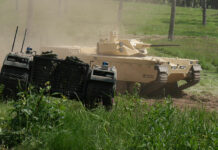Syrian Vice President Farouk al-Sharaa promised last week that Syria’s response would be forthcoming to avenge Damascus’ humiliation by the alleged Israeli air incursion into its airspace. Dr Boaz Ganor, executive director of the International Policy Institute for Counter-Terrorism (ICT) in Herzliya, has commented on the various options, that President Bashar Assad has in store. Ganor: “The Syrians have a variety of possibilities to operate against Israel, from urging Hezbollah to heat up the northern border through one action or revert to high-trajectory fire directed at Israeli targets.” In fact, the Israeli defense establishment does not rule out a Syrian attempt to respond sometime with missile fire and has already taken precautionary measures to meet this threat.
So are Israel and Syria edging closer to war? Tension between the two longtime enemies has increased substantially and the recent incident may well become the trigger for a full-scale conflict of some kind. One thing is quite certain, Syria sees the next war with Israel involving missile attacks on civilian infrastructure, an anonymous senior official in the Damascus Ministry of Defense, warned recently. Fully aware of Israel’s military superiority, especially it air force, the Syrian military prefers to avoid a direct, classic warfare confrontation with the IDF, in which it may well fare even worse than in the 1973 Yom Kippur War. Instead, the next war will involve Katyusha rockets and ballistic missiles that will target strategic points in Israel, and escalate dangerously into a full-scale city war.
According to Arab affairs expert Dr Guy Bechor, the Syrian assessment is a result of the Second Lebanon War. After that war, the Syrians understood that they do not need a large ground force to defeat Israel, but rather missiles aimed at dense Israeli population centers. Indeed, for the past two years the Syrians have been engaged in massive acquisitions from Russia, after an $11 billion debt was partially forgiven by Russia in 2005, and mainly through a tab taken on by Iran’s president Ahmadinejad.
One of the worst case scenarios facing the Israeli defense community, in its short-term assessment period is Syria’s chemical weapons potential, combined with its medium-range missile arsenal. (see defense-update analysis Syrian Ballistic Missile Arsenal by the author).
The Syrian Chemical Warfare Potential
Syrian chemical weapons development has been largely spurred by its disastrous conventional military defeats by Israel in 1967, 1973, and 1982. Syrian President Hafez al-Assad was Minister of Defense during the 1967 Six-Day War, during which the Golan Heights were captured by Israeli forces. After seizing power and assuming the presidency in 1971, Assad sought to bolster Syria’s strategic capabilities by pursuing the development of chemical weapons and ballistic missile delivery systems. After Syria’s air force was routed by Israeli jet fighters in 1982, losing 86 planes in a single engagement over the Bekaa valley in Lebanon, Syria apparently decided that surface-to-surface missiles could counter Israel’s air superiority. From a strategic perspective, long-range missiles such as the Scud could offer a means to deliver chemical weapons in response to Israel’s nuclear threat.
 For several decades, Israeli intelligence has monitored Syria’s clandestine efforts to reach strategic parity with Israel’s military potential. Fully aware of Israel’s unchallenged air superiority, Syria opted for missiles, but while these could reach into Israel, strategic effect could only be achieved by weapons of mass destruction, arming ballistic missile warheads. Realistic assessment ruled out Syria’s potential in developing nuclear capability in foreseen time, and although efforts were made to develop bio-weapons, Syria’s national emphasis during the last two decades has been devoted to chemical weapons.
For several decades, Israeli intelligence has monitored Syria’s clandestine efforts to reach strategic parity with Israel’s military potential. Fully aware of Israel’s unchallenged air superiority, Syria opted for missiles, but while these could reach into Israel, strategic effect could only be achieved by weapons of mass destruction, arming ballistic missile warheads. Realistic assessment ruled out Syria’s potential in developing nuclear capability in foreseen time, and although efforts were made to develop bio-weapons, Syria’s national emphasis during the last two decades has been devoted to chemical weapons.
The first to start this trend, was Abdullah Watiq Shahid, a nuclear physicist, who founded the government funded Scientific Studies and Research Center (SSRC) in 1971, ostensibly a civilian science agency, but soon operating under the cloak of high secrecy in developing weaponized chemical substances. The first facility, which started producing such material, was named the Borosilicate Glass Project, established with aid from a German company. The facility produced dual-purpose chemicals, such as dichloro ( 2- chlorovinyl) arsine, a substance which is the main source of the GB Sarin-A nerve agent. Another company named Setma sprung up in the outskirts of Damascus, which imported trimethyl phosphate from India, under the pretense to produce organophosphate insecticide for Syrian agriculture purposes. This substance, experts know, is a precursor for the weaponization of nerve agents.
A more ambitious program was started during the eighties, when Syria’s military patrons, the Soviet Union rendered vital information over the production process of advanced chemical warfare weapons. This brought about the development of aerial bombs containing binary sarin gas. The Syrians modified the Russian Zab – 2.5 incendiary shells to include chemical warheads, using DF and isopropyl alcohol substances in a binary system.
The binary projectile usually contains 2 separate, hermetically sealed, plastic-lined containers fitted one behind the other in the body of the projectile. In the sarin (GB) binary weapon, the forward canister contains methylphosphonic difluoride (DF). The rear canister contains isopropyl alcohol and isopropylamine solution (OPA). For safety storage, only the forward canister is in the munition prior to use. Before firing, the rear canister is added and the fuse is placed. The launching forces cause the canisters to break, thus producing GB within the projectile.
During the nineties, the Syrians explored new ways to develop chemical warheads of even more lethal capability. They used the ex-Soviet aerial cluster bomb PTAB-500 to modify its warhead to carry chemical weapons load.
But a real strategic nature breakthrough was achieved when Syrian scientists started to develop the notorious weaponization grade VX substance. VX, known under the chemical name O-ethyl-S-(2-isopropylaminoethyl) methyl phosphonothiolate rates among the most potent chemical weapons in the world. It has a high persistence and is life threatening when inhaled through the human respiratory system and penetrates the skin, with deadly effect. Israeli intelligence has long monitored activities in suspected VX production facilities near Hama and Homs in northern Syria.
 According to intelligence reports, Syrian air force have carried out a live chemical weapons bombing test in October 1999, when a MiG-23 jet dropped a bomb filled with an unidentified chemical weapons agent on a practice range. The test was detected by US spy satellites, which identified distinct coloration on the impact area, indicating a chemical explosion. According to intelligence estimates, Syria’s strategic chemical weapons stockpile is still primarily composed of the nerve agent sarin. However, latest reports indicate that Syria has successfully produced the much more persistent nerve agent VX and that it may have tested missile warheads armed with VX.
According to intelligence reports, Syrian air force have carried out a live chemical weapons bombing test in October 1999, when a MiG-23 jet dropped a bomb filled with an unidentified chemical weapons agent on a practice range. The test was detected by US spy satellites, which identified distinct coloration on the impact area, indicating a chemical explosion. According to intelligence estimates, Syria’s strategic chemical weapons stockpile is still primarily composed of the nerve agent sarin. However, latest reports indicate that Syria has successfully produced the much more persistent nerve agent VX and that it may have tested missile warheads armed with VX.
 In a study prepared by Dr Danny Shoham, a leading Israeli expert on chemical biological warfare, he explained that by using a combination of volatile (i.e., sarin) and more persistent agents (i.e., mustard, VX), Syria has the capability of utilizing CW in very different tactical scenarios. Sarin is extremely deadly, but it evaporates about as rapidly as water. An attack using this agent could inflict high casualties near a battlefront, but because it dissipates quickly it could permit an attacking force to seize territory without major risk to its own troops.
In a study prepared by Dr Danny Shoham, a leading Israeli expert on chemical biological warfare, he explained that by using a combination of volatile (i.e., sarin) and more persistent agents (i.e., mustard, VX), Syria has the capability of utilizing CW in very different tactical scenarios. Sarin is extremely deadly, but it evaporates about as rapidly as water. An attack using this agent could inflict high casualties near a battlefront, but because it dissipates quickly it could permit an attacking force to seize territory without major risk to its own troops.
A Syrian attack to retake the Golan Heights might include the use of sarin munitions (although it should be noted that Israeli troops deployed in the area are equipped with advanced chemical defense suites suitable for such a contingency.) Compared to VX nerve agent, sarin is also relatively easy to disseminate.
Due to its viscous nature, VX requires some sort of aerosolization. However, VX could be most effective in attacking an adversary’s rear areas, including military installations and logistical networks such as airports and train stations. Most people whose skin comes into contact with as little as one drop of VX will die, unless they receive very swift medical intervention. Furthermore, Dr Shoham warns, that VX nerve agent would remain hazardous for at least several days, requiring labor-intensive and time-consuming decontamination procedures.
The reliable German newspaper Die Welt reported in September 2004 that Syrian special forces held maneuvers with Sudani Government forces experimenting with chemical weapons of Syrian origin. According to the Welt report, in its original German language version, it was proposed that the arms be tested on the rebel SPLA, the Sudan People’s Liberation Army, in the south. Injuries caused by chemical arms were found on the bodies of the victims, according to unnamed sources quoted by the German daily Die Welt newspaper and witnesses who talked with the Arab news ILAF last month. Several frozen bodies arrived suddenly at the “Al-Fashr Hospital” in the Sudanese capital Khartoum in June that year. Die Welt claimed to have documents from Western intelligence agencies, concluding that an exercise in chemical warfare had indeed taken place. The reports, which had spread all over the global media in 2004, although vehemently denied, proved extremely embarrassing to Bashar Assad’s Alawite regime, at it was well known that Syria had already established the most deadly chemical warfare arsenal in the Middle East.
According to western intelligence sources based on information from inside Syria, a test with chemical weapons aerial delivery was staged by a special Syrian air force unit at its base near Homs. Strangely the test was made on July 11, 2006 just one day before the attacks by Hezbollah on Israel’s border, which triggered the Second Lebanon War. According to the reports, the tests involved the delivery of Sarin and VX through Syria’s Scud missile arsenal (Scud-B and Scud-C) produced in Syria with the help of North Korea.

The deadly effect of the chemical warfare agents produced at the el-Safir military complex near Haleb (Allepo) was demonstrated on the night of July 25, 2007, apparently by an accident, which happened while Syrian engineers working on a Scud C warhead. 15 syrians were reportedly killed in the explosion that, according to official Syrian sources, was caused by sympathetic explosion due to an uncommon summer heat wave (the event happened at night, when the temperature is relaively low). According to Janes Defense Weekly, the casualties also included Iranian experts that were present at the site. According to Jane’s, sarin and VX agents were dispersed over a large area after the accidents, causing severe burns.
More Images available at: Global Security
















